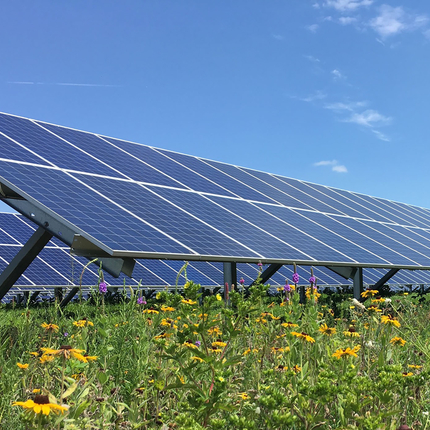By Cody Smith, former staff member. Co-authored by Kerri Johannsen, energy program director with the Iowa Environmental Council | Published in the Cedar Rapids Gazette on June 20, 2021
As Iowa begins writing the next chapter of our clean energy future, Linn County has arisen as an attractive location for renewable energy projects, such as utility-scale solar. In light of the public dialogue surrounding potential solar energy projects in Linn County, it is important to note that these projects can be both a tool for promoting economic development and investing in the conservation of our natural resources, namely soil and water.
The proposed utility-scale solar projects under consideration in the county have created quite a stir with misleading information and images being circulated about their potential environmental impacts. To put it plainly, these proposed projects will not destroy the natural environment or negatively impact the watershed if they are approved and built in line with Linn County’s existing ordinance for solar energy projects. In fact, with a diverse mix of native grasses and wildflowers cultivated on-site, these proposed projects can significantly improve water quality, reduce soil erosion, and provide habitat for wildlife and pollinators, going a long way to restore Iowa’s landscape.
Furthermore, by using wildlife-style fencing instead of traditional chain link fencing, these sites can be a home for upland nesting birds such as ring-necked pheasants, quail, and other grassland birds like the dickcissel.
Research from the Iowa State University prairie STRIPS project has shown that restoring perennial native vegetation can improve water quality by reducing nitrogen loss by 60 percent and phosphorus loss by 90 percent. In addition, the deep root systems of native plants can absorb and filter more water, providing an effective flood reduction practice as Linn County seeks to improve resiliency across the county. In fact, according to the Iowa Homeland Security and Emergency Management Department, perennial vegetation can reduce peak stream-flows by up to 40 percent during flood events.
Here’s the best part — if implemented with these goals in mind, Linn County can do all of this conservation while also creating jobs for locally-based service providers to graze, mow, and otherwise maintain these natural sites. The Linn County ordinance already requires that developers plant and maintain perennial vegetation to prevent erosion, manage runoff, and build soil. We encourage each solar project developer to negotiate these terms in good faith with the people of Linn County.
The transition to clean energy already has a long history in Iowa but there is so much more we can do and many more Iowans who can benefit. These proposed solar projects have the potential to create a significant source of new income for Linn County’s farmers and landowners. The projects are sited on land selected through voluntarily-negotiated lease agreements and landowners can expect generous payments ranging between $700 and $1200 per acre. It just makes sense to allow farmers to pursue a sustained and predictable income from their land that happens to require no additional inputs, provides crucial environmental benefits, promotes investment in the local economy, and grows the tax base for the county.
Linn County has the opportunity to serve as a model for other counties across the state in building sustainable solar. As you contemplate the suitability of this proposed investment, we look forward to seeing the people of Linn County take advantage of their already-existing strong siting requirements to leverage these potential projects as a tool for both conservation and economic development.
Feature photo provided by the Center for Pollinators in Energy.





